In my article on the Model 1881 Springfield Shotgun, we saw that the shotgun was in service for about 26 years, stretching from 1881 to about 1906. Through these years and beyond, we see the shotgun show up in news articles.
I think these are really neat bits of information – the articles bear witness to the gun’s changing status from a service weapon to a collectible. I thought I’d share some of the more interesting anecdotes I’ve run across, along with some observations about what they reveal.
First, this visual timeline should work as a handy refresher on the model 1881’s evolving status from production to present day. The faded areas are meant to convey periods of transition. You can click/tap on the image to enlarge it.

In all of the following articles, any emphasis will be my own. I’ve reproduced the text verbatim, spelling mistakes and all.
You’ll Shoot Your Eye Out!! (1902)
I’m going to start with this article from Fort Riley, Kansas in 1902:
“The members of the garrison have been figuring in a chapter of accidents during the past ten days. Two men had bad falls, involving more or less serious sprains and fractures, several men were badly bruised and cut up in town and one man shot off a finger with a Springfield shotgun. The hospital attendants have been having a busy time in consequence.”
Dec. 21, 1902, The Fort Riley Guidon, Page 7
In this case, the article mentions the shotgun in the context of the “members of the garrison”, so it can be assumed that the shotgun is a service weapon rather than in private hands. This fact fits comfortably with both the location of the event and the date. It wasn’t until 1904 that General Order No. 37 was issued which required all shotguns to be turned into Springfield Armory or Rock Island Arsenal. The location, being west of the Mississippi, is in keeping with where we know the shotgun was issued.
Military Surplus (1907)
But after the recall from service, the shotguns didn’t stay locked in the Armory forever. In 1907, we see a notice published in The Washington Post announcing that the Springfield Armory would auction off surplus weapons to the highest bidder. Among the weapons offered would be the Springfield shotguns:
“Preparations are being made by the ordnance department of the army for the disposition of a quantity of property for which the government has no further use. At the Springfield Armory, Mass., there soon will be sold to the highest bidders a number of Gatling guns, caliber .45, which are not adapted for mounting on modern carriages, …and Springfield shotguns, sabers and swords, miscellaneous tools and other ordnance stores.”
Jun. 16, 1907, The Washington Post, Page 2
Wanna Trade? (1908)
After 1907, the shotgun appears in the context of private ownership. Here’s a man advertising his in 1908, along with the reloading kit issued with the gun (presumably):
“EXCHANGE – SINGLE – BARREL Springfield shotgun, shells and reloading outfit; want small hand-power press.”
Apr. 26, 1908, The Oregon Daily Journal, Page 44
The Model 1881 was indeed issued to companies with shells and a reloading kit. These supplies for the shotgun were manufactured at Frankford Arsenal. In the arsenal’s monthly summary statements of ordnance stores on hand this kit is referred to as the “Shotgun outfit”. Did this person have the complete package on hand? The Model 1881 reloading kit would be an incredibly rare find today. I’m not sure any intact kits are known to exist, frankly.
Tragedy in the News (1907)
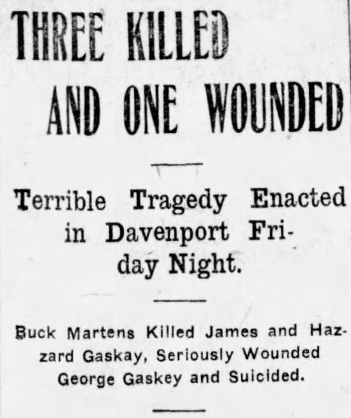
Next to a large piano advertisement in the Quad-City Times of Iowa, we see a story of jealous rage – a man with a .38 caliber revolver attempts to kill the whole family of a man who married his ex-wife. He kills two, wounds a third, and then “suicided”. The family attempted to employ the shotgun in defense, though failed to stop the attack.
“He was peeling potatoes for breakfast when the latter came in and asked for his gun, a ’20-gauge single-shot old Springfield shotgun’. Hoeper gave him the gun and two shells. Hazzard put one shell in the gun and went out, Hoeper following but remaining behind the hen-house. He heard the shot which wounded George Gaskey in his own house.”
Oct. 20, 1907, Quad-City Times, Page 13
The rest of the story is not relevant and frankly it’s an exhaustive tale of woe with which I need not burden you. It shall suffice to say that this is indeed our gun, in private possession, and already regarded as an antiquated specimen by its owner(s).
By 1907, of course, revolvers, lever-actions, and pump-actions had all proved their worth and entered common use. In fact, the Browning Auto-5 had already been patented. Easy to see why, by this time, a trapdoor conversion would have been regarded as an anachronism.
Used by the Police (1909)
We don’t often think of Model 1881 re-entering public service. However, the path taken by military surplus to local police departments is a well-worn one. Here’s one documented case in 1909.
“A calm nerve, a trusty shotgun and prompt action stopped one W. L. Edwards as he was in the act of entering the home of W. A. McMullen on Vine street…. It was about 2 o’clock in the morning. Detective Woy had gone on duty before midnight, and was stationed in the second block of Vine street. He stood in a shadow, well back from the street, armed with a Springfield shotgun, ready for the approach of the burglar who has been doing his own sweet will for several months.
…
This was Woy’s opportunity. He moved out where the flitting rays of the mood would catch the steel of his weapon and took deliberate aim. The man saw the officer and the gun and backed away from the window.”
Apr. 08, 1909, Chattanooga Daily Times, Page 5
A dramatic telling, but really nothing to take from this other than the fact that the shotgun is seen in police service after its military service. Given the limited quantity of shotguns that survived up to 1909, I can’t imagine this was too terribly common.
A Murder in Gulfport (1910)
We return to a sinister context in 1910 when we find the shotgun in a Mississippi barber shop:
J. C. Autrey, the man who shot and killed Ben D. Currie at Bond, Miss., something over a week ago, …is back in jail at Gulfport…. The evidence in court went against Autrey and it was shown that he had very much been the aggressor in the trouble that led up to the shooting. Autrey had no less than five weapons in his barber shop the on the day of the killing, a Savage rifle, a 22 caliber rifle, a Springfield shotgun and a revolver and one other…. Currie came back and Autrey leveled his rifle on him. Currie said he would kill Autrey and later did begin shooting at him with his revolver. Autrey said that Currie fired four times, the first bullet missed, the second grazed his forehead and the third entered his shoulder and the fourth struck him in the leg.
Currie then got behind the petition and Autrey fired through at him, shooting him through the breast. Currie walked about 60 feet and sank down. Two men picked him up and Autrey even then leveled his rifle at the man. Autrey, it is said, made a boasting remark about his good aim.”
Apr. 23, 1910, The Gulfport Daily Herald, Page 5
I confess I’ve quoted more than necessary because the context is downright interesting. A couple points stand out to me. The event occurred in 1910 – about six years after the shotgun was recalled from service. Like Chattanooga, TN, this town of Bond, MS is well outside of the area where the shotgun was initially issued (“posts of the West”). It stands to reason that you’d be more likely to find these shotguns here than in their former theater of operation. After the recall of 1907, the guns radiate out from Springfield and Rock Island, rather than being found near the western posts. Perhaps the shotgun was bought as surplus, resold as mail-order, or traded its way South. Maybe it has a much more interesting history, along with its owner.
Cocaine and “Useless Relics” (1901)
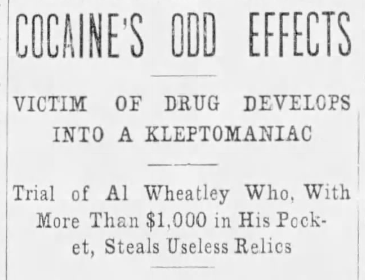
We do find that the shotgun was sold to private parties before that 1907 auction at Springfield Armory. A story in the Los Angeles Evening Express tells us of a Springfield shotgun being stolen from a local store that was handling condemned arms from the Benicia armory.
“Al Wheatley, cocaine fiend and mac, is on trial before Justice Morgan and a jury today on a charge of petit larceny. Dec. 10, Wheatley entered the store at 224 North Main street, where a sale of condemned guns from the Benicia armory was being conducted, on two separate occasions, and stole a Springfield rifle and a Springfield shotgun, which he concealed in a nearby saloon.”
Dec. 27, 1901, Los Angeles Evening Express, Page 3
He was found to be carrying $1530 in his pocket, and stealing guns valued at $10 in total. Now you’re thinking, “Huh. $1530”, but let me remind you that 1901 dollars were worth far more – that’s about $56,000 in 2024 dollars. In his pocket. Son. Paper said he was a “mac”, and I guess so.
Note that Al Weatley doesn’t blame the cocaine for his behavior. Indeed, he blames his lack of cocaine.
“Wheatley’s defense is that he was not in his right mind when the thefts were committed. He says that, owing to his being without his usual allowance of cocaine, he did not know what he was doing; that he had no use for the guns, but was seized with an irresistible impulse to take them.”
Dec. 27, 1901, Los Angeles Evening Express, Page 3
“Seized with an irresistible impulse” probably describes all of us at a gun show.
An 1896 Murder in Missouri (1896)
Going back further, we seem to find the shotgun in private hands well before it was surplused and far away from any armory. Here’s a curious story from 1896 in Missouri:
“Charles Huffman and Bill Griffith were arrested at De Witt today for the murder of Henry Miles on Monday night. The only evidence against them is that a shell from a No. 12 breach-loading Springfield shotgun was found near where Miles was murdered, and these two men are the only ones in or near De Witt that own this kind of a gun. On the night of the murder a woman heard a man say: ‘If he is not dead now he never will be.’ The woman thinks it was Huffman’s voice.”
Jun. 04, 1896, The Kansas City Times, Page 1
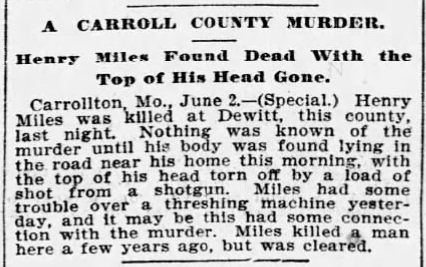
Here’s what stands out to me in this article. If we take it on its face, the details don’t line up. The shell is listed as a “No. 12”, and I would assume this means 12 gauge. The Springfield shotgun was only made in 20 gauge, so this is an odd leap to make. The shells issued for use with the shotgun were distinctive enough to make an association – tinned cartridges from Frankford Arsenal – but why the incorrect gauge? It’s literally printed on the cartridge. I considered this may be a “Springfield” brand of shotgun made by Stevens but to my knowledge those don’t start appearing until about 25 years later. A Springfield shotgun refers to something very specific in 1896.
Maybe the reporter got it wrong, maybe the person relaying it to the reporter got it wrong. Maybe the reporter embellished the story. Either it’s not a Springfield shotgun, or it’s not a 12-gauge. For fun, let’s proceed as if they embellished the numbers to bolster the headlines, and the name is the correct detail.
So how would it enter private hands? This takes place in 1896, when the shotgun is certainly still a service weapon, though about 10 years after the last of them were made. It could have been absconded by a deserter or sold surreptitiously out of the back door of a fort (both of which happened occasionally if not regularly). Perhaps an officer resold their private purchase. Perhaps it was a condemned gun that was sold off and repaired, like the gun stolen by Al Weatley in the much later story we recounted above.
Is it one gun owned by the two men? Were they housemates? I find it interesting that the paper says, yeah, these two guys are the ONLY ones around here with this gun. The statement certainly implies that owning the gun is unusual. It is one of less than 1400 in the nation, after all, and at this point in time would ordinarily be in the possession of the military.
An article in the Jefferson Democrat a week later relays that, “The men are the only persons in the neighborhood who own No. 12 breach loading shotguns.” That implies multiple shotguns. I don’t know if these two men shared a single gun between them as the first article seems to imply, or if the police just rounded up every man (all two) who owned one of these shotguns to cast a wide net.
It’s possible that Mssrs. Huffman and Griffith are soldiers. I think that it’s highly unlikely, as such details are often noted in these stories.
A day earlier, a story in the same paper had brought the first announcement of Mr. Miles’s death with some interesting detail:
“Last night about 11 o’clock Henry Miles was waylaid and shot near his home in DeWitt. The assassin used a double-barrelled shot-gun and shot the top of Miles’ head nearly off.”
Jun. 03, 1896, The Kansas City Times, Page 2
We can only speculate why they would assume a “double-barrelled [sic] shot-gun” was used when no evidence was left behind. The June 3rd article reports that nearby people “heard the shot”, which I read as only a single shot.
It turns out that the double-barreled shotgun belonged to the victim! An article in the Clinton Daily Democrat on June 4th tells us that the double-barreled shotgun actually belonged to Mr. Miles, found beside him with neither barrel discharged.
I got really distracted by this story. After further digging, it only gets more strange. I found an article from the Miami Weekly News – Miami, Missouri, not Florida – with a ton of additional detail. This article notes that the shotgun found next to Miles was a “repeating shotgun” with six loaded shells (perhaps a Winchester 1887 with five in the tube and one in the chamber??). What was first assumed to be a suicide by the crowd was determined to be a murder on account of the gun having not been fired. An empty shell was found about 15 feet away near a small bush, though no mention of further detail. This shell is what was later identified by other articles as has having come from a “Springfield shotgun”.
It’s confusing, and I’m sure there’s a degree of embellishment in some of these reports. Let’s move on.
An Heirloom (1917)
In more modern times the shotgun is still making appearances.
In California in 1917, the shotgun shows up being willed to another upon the death of its owner:
“An old single-barreled Springfield shotgun has been bequeathed to a lifetime friend, Pell Ennon of San Franscisco.”
Aug. 16, 1917, The Sacramento Star, Page 2
You can read too much into these old clippings, but I think this tells us that the shotgun is seen as having value even if its utility is waning.
Frankenstein’s Monsters! (1920-)
About this time we start seeing a lot of ads for “Springfield Shotguns”, and these can be just about anything from frankensteined firearms made from spare parts of Model 1881’s or more modern creations from other companies, like J. Stevens Arms Company. “Springfield Arms” was a trademark employed by Stevens and the guns were advertised prolifically. Of course, these “Springfield shotguns” came in a variety of calibers and configurations and have nothing to do with the national armory.
The Blackbird Annihilator (1939)
But the original is still in use! Here’s a story from Iowa in 1939, slaying the birds.
H. J. Weber of Cresco is the official blackbird annihilator of that city, a position he has occupied for a dozen or more years by reason of having been granted permission by the town council to use a shotgun on these nuisances which congregated in great droves at a certain locality in the city. Mr. Webber gets a 2c bounty for each bird killed and during the past twelve years he has slaughtered nearly seven thousand blackbirds. He uses an 1881 model shotgun.”
Jul. 13, 1939, Postville Herald, Page 2
I’ll do the math for you: described in another article as an “aged resident”, this guy has been employing his shotgun since at least 1927 and has made $140 dollars in bird blood money by ’39. That’s about $3,125 in 2024 dollars. He reloaded quite a few cartridges during that time. I’ve read that in 1933, IMR powders were about $1.70 per pound, and shotshell primers were $6 per thousand. He did pretty well, I should think. Maybe he was using black powder. Who knows what he was using for shot.
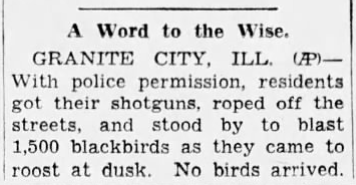
Des Moines Tribute, Aug 8, 1943
Apparently, Mr. Weber’s pastime caught on. Granite City in Illinois found they didn’t have to pay people to shoot birds in the city – they could make a block party out of it, and they did. In 1943, however, no birds showed up for the party (see image inset).
The Secret to Happy Hunting (1950)
In Maine in 1950 we see a reference to the Model 1881 in an article about the upcoming hunting season:
“The secret to happy hunting in New England lies in the variety of opportunity afforded in its forests, swamps, meadows and farmlands. The amateur with an old ‘trapdoor’ shotgun who seeks birds or small game can find just as much adventure there as the experienced hunter with his expensive shooting iron….”
Oct. 04, 1950, Newsday (Suffolk Edition), Page 76
Here again we see the shotgun far away from its wartime theater and closer to the Armory, which makes perfect sense. This article is evidence that the Model 1881 or some modified form of it is still in use by hunters in 1950, though considered less than ideal. The word ‘amateur’ isn’t being used as a contrast with a “professional” but rather to denote a level of ineptness – either you’re using that gun because you have nothing better or don’t know any better. By 1950, there are far better shotguns to be hunting with. Heck, in 1881 there were far better shotguns to be hunting with!
Now a Collectible (1968-1988)
By 1968, the Model 1881 had cemented its status as a collectible firearm. In the Rapid City Journal we find an interesting article about gun collecting. Kermit Edmonds, Museum chief of the Wyoming Archives and Historical Department, discusses the evolving demands of maintaining firearm collections and is photographed holding a Model 1881.
“Also in the museum’s racks is a very rare model 1881 Springfield forager’s shotgun 20-gauge, issued where necessary and possible on the frontier, two to a company of infantry or cavalry, so troops could add wild meat to their rations.”
Mar. 17, 1968, Rapid City Journal, Page 15
By the late 1960’s, the gun is regarded as “very rare”.
Twenty years later, we see an article in The Columbian featuring a private gun collector, Ken Foster. Mr. Foster explains how he got hooked on the pastime of collecting and laments the declining stock of collectibles on the market. One of his treasures is his Model 1881:
“Foster bought his first antique gun, an 1881 Forager shotgun, in The Dalles, his hometown. He paid the seller $300. ‘I figured he didn’t know what he was doing and I didn’t know what I was doing, so we’d see who came out ahead.’
Foster did. The gun is now worth about $1500.”
Jul. 6, 1988, The Colombian
Well, $1500 in 1988 is worth about $3900 in 2024, which means that a good specimen has held its value pretty well. Indeed, I’d say Mr. Foster did alright.
Conclusion
This survey of period newspaper articles reflects the changing role of the Springfield Model 1881 trapdoor shotgun, from a military arm, through surplus use, and evolving into a collector’s item. From providing utilitarian value as a hunting tool to providing intrinsic value as a collector’s item.
Hope you enjoyed reading these excerpts. I leave you with this 1968 photo of Mr. Kermit Edmonds, in his lab coat, holding up a Forager for the newspaper photographer of the Rapid City Journal. He has the classic gun collector’s “the metal is lava” grip on the Marlin in his right hand. We’ll return to this photo in a future article, I’m sure.
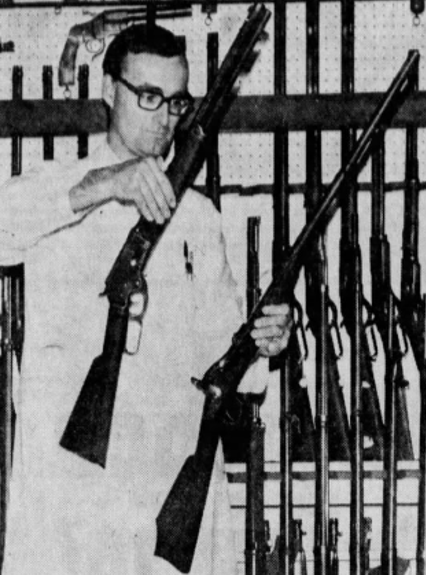
Photo from Rapid City Journal, 3/17/1968, “No Room For ‘Hacks’ In Gun Collecting Now”

